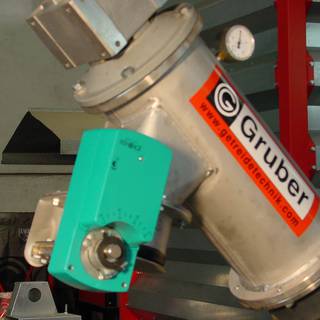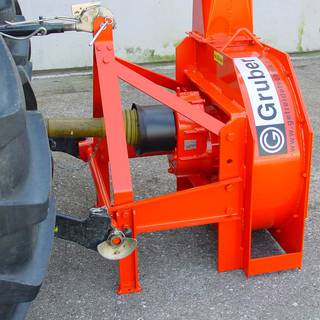The advanced way to store and process wet maize.
Gruber whole grain silage
As a general rule, please note:
- The entire silo system must be absolutely gas-tight and watertight. A leak test is required before filling the silo.
- The silage funnel base has an inclination of 50-60°, depending on the design, to ensure that the maize grains do not slide down. Concrete silos must be provided with a polyester coating on the inside.
- The size of the gas compensation balloon should be approx. 8 – 10 % of the silo volume for concrete silos and approx. 10 – 12 % for enamel silos.
- For 1 ha of maize you need approx. 14 – 20 m³ silo volume.
Cone discharge
Cost-effective solution – The stainless steel approach funnel (gas-tight) remains smooth and corrosion-resistant in the silo. At the same time, the whole-grain hopper serves as a formwork aid when concreting the silo gel.
Gas compensation balloon
The size of the gas equalisation balloon should be approx. 10 % of the silo volume and ensures pressure equalisation in case of temperature fluctuations. It is made of acid- and light-resistant material. In addition, the gas equalisation balloon also serves as a gas reserve tank.
Edelstahl-Entnahmeschnecke
A special Gruber advantage is the 0-ring clamping seal, which provides a 100% seal between the stainless steel approach funnel and the plastic auger tube.
The stainless steel extraction auger runs in a thick-walled weatherproof PVC pipe with a diameter of 200 mm.
The stainless steel discharge auger is equipped with an electronic speed control (frequency converter). The gas-tight auger discharge flap can be operated manually, electrically or pneumatically.
Pressure limitation
A special 3-chamber safety valve in stainless steel design, which is filled with antifreeze, serves to limit the pressure in case of overpressure or underpressure.
Whole grain fan
The whole grain fan is used for pneumatic filling of high silos. The wet maize is gently fed into the discharge nozzle of the conveyor fan by means of a wet maize auger.
Whole grain mill
There are 8 different types of whole grain mills:
- GK 311 ( fan 2-blade, 3-blade or 6-blade) – motor 11 kW
- GK 315 ( fan 2-blade, 3-blade or 6-blade) – motor 15 kW
- GK 185 ( fan, 3 blades or 6 blades) – motor 18.5 kW
Different fan designs allow the whole grain mills to be optimally adapted to the local conditions.
The fineness of the ground material is changed by different sieves.
- The daily removal can be fully automated (labour and time saving).
- There is no more reheating, regardless of whether little or no feed is taken.
- High-impact filling of the silo with low energy input (no milling during harvesting). Staged filling or new storage also possible.
- Daily removal results in a freshly ground feed. The aromatic smell of maize increases feed intake.
- High nutrient content in feed – up to 900 GN per kg dry matter.
- Frost-proof system: Even at -20° C to – 25° C there are no withdrawal problems. The feed temperature is always even.
- Feeding and removal are cost-effective: The feeding and removal technology can be used for several silos.
Thermal fluctuations (e.g. temperature rise) cause the gas to be blown into the balloon at the top of the silo ceiling via a pipe and a control valve. When it cools down, the gas is sucked from the balloon into the silo. The control valve with gas line and equalising balloon is absolutely necessary so that the gas produced by the condensation is collected.
In the past, it was erroneously assumed that the carbon dioxide was located at the top of the silo and the air at the top. The fact is that a mixed gas with a different oxygen content is produced. The ideal values are between 0.1 and 0.3 percent oxygen. All values above this deteriorate the quality of the maize.
If no balloon is used, oxygen regularly enters the silo when it cools down, i.e. in the evening, and is thermally mixed the next day. This increases the oxygen content, and yeast and mould cause secondary fermentation. Systems without gas balloons are therefore generally not built!
When filling silos using an elevator, large conveying capacities are achieved with little effort, making it particularly economical! The material is transported extremely gently with the elevator.
| Motor | approx. grinding capacity per hour | approx. blowing capacity filling |
|---|---|---|
| 11 kW | 1200 – 2500 kg | 12 – 20 to |
| 15 kW | 1500 – 3500 kg | 12 – 20 to |
| 18,5 kW | 2000 – 4200 kg | 12 – 20 to |















